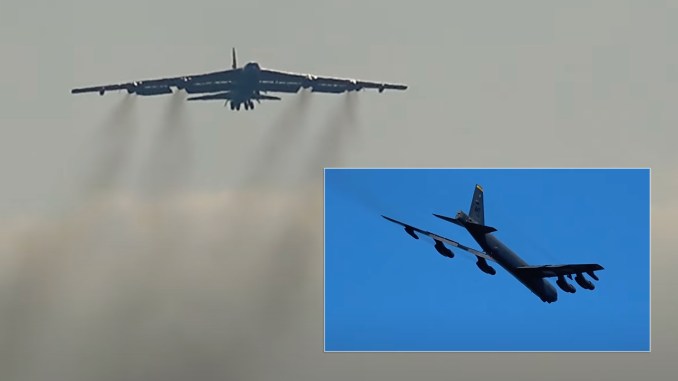
This is something you don’t see too often: a B-52 on final performs a go-around because a U-2 hasn’t vacated the runway yet.
On Monday May 20, 2024, two U.S. Air Force B-52 Stratofortress bombers assigned to the 5th Bomb Wing from Minot Air Force Base, North Dakota, arrived at RAF Fairford, in the U.K., for a routine bomber task force deployment.
The first two strategic bombers were joined by two more B-52 which arrived on Wednesday and Thursday bringing the total Stratofortress bombers assigned to the 69th Expeditionary Bomb Squadron under the banner of Bomber Task Force Europe 24-3, to four aircraft.
As usual, the U.S. Air Force personnel and aircraft of the BTF will collaborate with NATO Allies and other international partners to synchronize capabilities and reinforce security commitments within the U.S. European Command’s area of responsibility. We will probably see the B-52s fly missions towards Eastern Europe, the Arctic Region, the Baltics, the Eastern Med Sea and Middle East, as done more or less regularly during the previous deployments.
In fact, these BTFs are a way for the U.S. to regularly showcase its dedication to NATO Allies and partners through deterrence missions that often see the integration with allied assets.
BTF 24-3 is also integrated into Large Scale Global Exercise 2024, a comprehensive initiative linking military operations across various combatant commands. LSGE24 allows U.S. Joint Forces to train with Allies and partners, fostering shared understanding, trust, and interoperability in addressing global security challenges.
Interestingly, something unusual happened on May 20, when the first B-52H, airframe 61-0018, flying as GROAT 11 was on final for landing at RAF Fairford: the Stratofortress was configured for landing after a U-2 had just landed and was still on the runway.
The B-52 performed a go-around and landed a few minutes later. The scene was captured by our friend and contributor @Saint1Mil in the video that you can find here below.
Go-Around
While you don’t happen to see a B-52 perform a go-around too often, go-arounds are a standard safety procedure and are practiced regularly by pilots during training. They ensure that the aircraft can safely abort a landing if conditions are not ideal, maintaining the safety of the crew (and passengers).
Go-arounds can be performed for several reasons (some of those can occur simultaneously):
- Unstable Approach: The aircraft is not in the proper position or configuration for a safe landing. In this case, it’s better to perform a missed approach
- Runway Obstruction: There is another aircraft, vehicle, or object on the runway.
- Traffic interference: Another aircraft is spotted in the vicinity of the airport or glide path making the approach potentially unsafe for the risk of mid-air.
- Weather Conditions: Sudden changes in weather, such as wind shear, wing gusts or poor visibility.
- Technical Issues: Any mechanical or technical problems that could affect the safety of the landing.
- Pilot’s Decision: The pilot may determine for any reason (including those listed above) that a landing is not safe or advisable.
This Author has had the chance to fly go arounds aboard many types of aircraft: during pilot training in Cessna C-150/152/172; as passenger in a civil aircraft (that was forced to perform a go-around seconds before touch down at Charlotte Douglas International Airport because of a wind gust); as a backseater in various military aircraft (including the TF-104 and the TAV-8B+ Harrier).
- SEO Powered Content & PR Distribution. Get Amplified Today.
- PlatoData.Network Vertical Generative Ai. Empower Yourself. Access Here.
- PlatoAiStream. Web3 Intelligence. Knowledge Amplified. Access Here.
- PlatoESG. Carbon, CleanTech, Energy, Environment, Solar, Waste Management. Access Here.
- PlatoHealth. Biotech and Clinical Trials Intelligence. Access Here.
- Source: https://theaviationist.com/2024/05/23/b-52-bomber-go-around-at-raf-fairford-because-of-a-u-2-on-the-runway/?utm_source=rss&utm_medium=rss&utm_campaign=b-52-bomber-go-around-at-raf-fairford-because-of-a-u-2-on-the-runway




